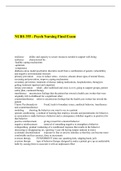Exam (elaborations)
NURS 355 - Psych Nursing Final Exam Questions and Answers 386 Terms - Chamberlain College of Nursing
- Course
- Institution
NURS 355 - Psych Nursing Final Exam Questions and Answers- Chamberlain College of Nursing/NURS 355 - Psych Nursing Final Exam Questions and Answers- Chamberlain College of Nursing/NURS 355 - Psych Nursing Final Exam Questions and Answers- Chamberlain College of Nursing/NURS 355 - Psych Nursing Fina...
[Show more]



